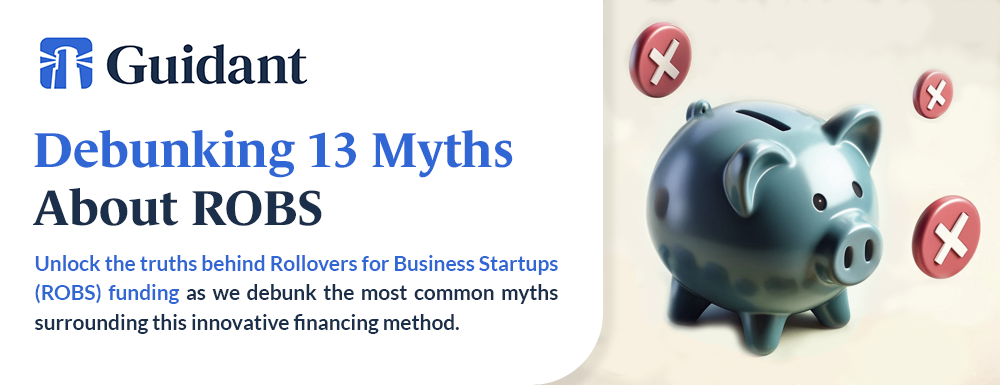

Debunking 13 of the Biggest Myths About ROBS
Unlock the truth about ROBS. Discover why entrepreneurs are turning to this financing option and dispel common myths

More and more entrepreneurs are using Rollovers for Business Startups — ROBS for short — to fund their dreams. In fact, over half of business owners surveyed in our Small Business Trends studyused ROBS to finance their businesses this year. Yet, it’s surprising how many current and aspiring small business owners believe all the wrong things about ROBS.
In what follows, we’ll dispel many of the biggest myths surrounding ROBS and demystify its complexities — all while clarifying the potential advantages of using ROBS. Let’s get started.
Do you qualify for ROBS? Answer These 5 Questions to see if you qualify now.
Debunking 13 ROBS Myths

Myth 1: ROBS Is a Loan
While loans and ROBS are both financing methods for business needs, ROBS is not a loan. ROBS utilizes your own retirement funds and creates a new retirement plan for your company that all employees can contribute to. If you obtain a loan, you’ll have to pay debt service every month. But because ROBS uses your own funds, you won’t have to pay debt service. It leaves your cash flow clear to be used in the business as you see fit.
Myth 2: ROBS Can’t Be Used with Every Type of Business
ROBS can be used with virtually every type of business and industry. The exception is that the business must be legal on the Federal level. So, for example, you could not fund a marijuana-based business even in states where marijuana is legal because it is not legal on the Federal level.
Myth 3: ROBS Can’t Be Used to Fund a Franchise
This one is totally untrue. ROBS has been used by thousands of franchisees to fund the initial purchase of a franchise, expansion of their franchise holdings and a myriad of business needs on the part of the franchisee. ROBS, unlike other some other forms of financing, can be used flexibly for either a franchise or a stand-alone business.
Myth 4: ROBS Is a Method of Tax Avoidance
ROBS is definitely not tax avoidance. This myth may derive in part from the tax treatment of the retirement funds used. Ordinarily, if you want to withdraw tax-advantaged retirement funds like 401(k)s and traditional Individual Retirement Accounts (IRAs) before the age of 59 1/2, the Internal Revenue Service (IRS) taxes the withdrawn funds and also levies a 10 percent tax penalty for early withdrawal. But ROBS uses a unique structure to withdraw the funds, and the IRS allows qualified funds to be withdrawn without taxation. In addition, the 1974 Congressional enactment of the Employee Retirement Income Securities Act (ERISA), along with key IRS provisions, allows for ROBS to help you grow both your business and your retirement savings at the same time.
Myth 5: ROBS Works for Every Business Entity
To avoid taxation on your retirement funds, ROBS need to be structured according to specific requirements. That means your business must be registered as a C Corporation (C Corp). How does it work? Briefly, a C Corporation is created, along with a new retirement plan for that C Corp. All workers, including you, must have access to that new retirement plan. Your qualified retirement funds are then rolled over into the new retirement plan. You then purchase stock in the new C Corp with the funds in the new retirement plan. After that, the stock can be sold, and the proceeds used to fund the business.
That being said, if you want a C Corp and Limited Liability Company (LLC), you can setup your C Corp to run an LLC.
Learn more about how ROBS works in What is ROBS? How 401(k) Business Financing Works.
Myth 6: Your Investments Aren’t Diversified With ROBS
Diversification is a method of avoiding risk in investments by investing in several asset classes, such as stocks, bonds, and real estate. In fact, ROBS can be viewed as a form of diversified investment; it’s an investment in your business. The myth, though, may rest on the assumption that the retirement funds used for ROBS are all invested in your business, and thus not diversified beyond it. But, of course, you don’t have to use all your retirement funds when you use ROBS. ROBS providers generally require a minimum of $50,000, but your decision on how much to leave in retirement funds and how to much withdraw for ROBs is entirely up to you.
Myth 7: 401(k)s Are the Only Retirement Funds That Can Be Used with ROBS
This myth likely owes its force to the fact that 401(k)s are frequently used for ROBS, to the point where it’s also known as “401(k) business financing.” But many types of tax-advantaged retirement plans can be used, including traditional IRAs and many others. For a complete list, see here.
Myth 8: You Must Quit Your Job to Use ROBS
Many aspiring startup entrepreneurs plan to launch a small business while continuing to work at their current job. Can you do that if you use ROBS? It depends. If you plan to use retirement funds that have nothing to do with your current job (i.e., from a previous job or your own self-directed retirement funds, such as an IRA), quitting your job or not is entirely up to you. However, if you plan to use the retirement funds from your current job, it depends on whether you are vested and on the plan administrator’s rules and regulations about withdrawal.
See Using ROBS to Fund Your Small Business While Employed to learn more.
Myth 9: Absentee business owners can use ROBS
Many rules and regulations govern ROBS, and one of them is that you can’t be an absentee owner.A good rule of thumb is that you must work at your company a minimum of 500 hours in a year.
Myth 10: ROBS Takes Months To Establish
The average time to establish ROBS financing is a month — meaning you can utilize your retirement funds much more quickly than you can funds using other financing methods. But note that other factors figure in the timing as well, such as how quickly you file any business documents required for the C Corp, how quickly your retirement funds are disbursed, and how quickly your state moves on the incorporation for the C Corp. States vary in their speed of processing.
Myth 11: ROBS and Self-Directed IRAs Are the Same
Funds from self-directed IRAs (SDIRAs) can also be used to finance a business. But there are very significant differences between SDIRAs and ROBS. If you finance a business with a SDIRA, you cannot work for the business or draw a salary. With ROBS, by contrast, you must work for the business and you must draw a salary. In addition, SDIRA funds may be subject to the unrelated business income tax (UBIT), while funds used for ROBS are not subject to tax.
Learn more about the differences between ROBS and SDIRAs here.
Myth 12: ROBS May Raise Legal Issues
ROBS is completely legal. Still, it’s advisable to work with an attorney and an experienced ROBS plan administrator to make sure that you are compliant with all requirements and regulations, including those from Federal government agencies such as the IRS and the Department of Labor (DOL), which oversees the new retirement plan.
Myth 13: ROBS Is Extremely Complicated
Frankly, there is some truth to this one. ROBS is regulated by Federal government agencies and must be set up using a specific method and using a particular corporate structure. Administration and paperwork for the DOL must be filed every year. All IRS rules and regulations must be complied with. Most folks aren’t familiar with ROBS before they begin to consider it. That alone could make it seem complicated. Loans are much more familiar to people, who may have applied for loans — for houses, cars or other assets — at some point in the past.
The key is to work with experienced plan administrators and professionals, such as lawyers, to make sure all rules and regulations are followed and that the company is run to follow them in the future.
Advantages of ROBS
The fact is, ROBS has many advantages for current and aspiring small business owners, including:
- ROBS leaves you free of debt service. Plus, you can access your retirement funds early with zero withdrawal fees.
- ROBS can be used for multiple business purposes and in combination with other financing strategies such as SBA Loans.
- ROBS does not require that you have a specific credit score (which business loans do) or that you collateralize your assets such as your house (which business loans can do). Therefore, ROBS is a very good choice if your credit score may preclude a loan or you don’t want (or have) to collateralize a loan.
- ROBS allows you to save for retirement in the new company’s 401(k), which means your retirement savings can grow as your business grows.
- ROBS can be used with multiple funding methods. In fact, many choose to use ROBS as a down payment on a business loan.
The long and short of it is, knowing which ROBS myths are false and what ROBS really is will help you decide if ROBS is the right financing choice for you and your business.
Is ROBS the right investment for you? Find out in Maximizing Your Retirement: ROBS as an Investment.
Guidant Financial: An Experienced ROBS Provider
At Guidant, we’re the experts in ROBS. With over 30,000 successful setups, we’re America’s top choice. We can advise you on whether ROBS is a good choice for your business, explain ROBS in detail, set up ROBS for your business and recommend professionals to assist in the process. Plus, we can help you in the yearly administration of your plan, maintaining compliance and taking the complexity out of ROBS. Contact us today about ROBS as a financing choice.
Call us today at 425-289-3200 for a free, no-pressure business consultation to get started— or pre-qualify in minutes for business financing now!
Read More


Where are You Going to be in 5 Years?
By Matt Carle, Main Ascent Business Brokers and Advisors
Do you have a destination in mind?
I had a client tell me recently “I don’t ever see myself retiring.” My next question was what kind of work do you want to be doing in five years? He quickly told me he wanted to be able to keep pulse on his business finances, help develop systems, and make sure the business was growing on both the client and employee side. That answer instantly lined up with the vision we had built for his company, and it was a confirmation that we were on the right track with our work together. His clarity on that question took time for him to realize, he wasn’t always so sure what kind of work he wanted to do, or whether or not he’d continue to work into his 70’s and beyond.
This isn’t the case for everyone – there are plenty of people who want to move into retirement sooner rather than later, selling their business or passing it along to family is what fits best in their picture. So we build a plan for that – set up business systems that don’t rely on the owner, thinking about how to transfer roles and responsibilities to the staff and new owners. No matter what the owner wants to accomplish we can build a plan for it. And that is the point. As a business owner your business should support you in the life that you want to live.
The client this example has a clear picture of what he wants to do and how he wants to do it over the next few years, and it allows us to focus energy on building a business that allows him to do just that. Everything we decide to do gets measured against the question “Does this move you closer to your vision?” if it does then the decision is simple, if it doesn’t then we have to pause and evaluate the decision against those criteria. It’s almost binary – yes or no – does this move you closer to where you want to be?
Plenty of people change their mind along the way, deciding they’d like to stay on working for a while longer – or sometimes the decision to leave is made for them by circumstances outside their control. Having a plan and a goal that we’re working toward makes those kinds of changes easier to manage. It’s much easier to pivot and sell a business if it’s required when we’re already building a company that doesn’t rely on the owner to operate it successfully. Potentially changing your mind is not a reason to avoid planning, it’s a reason to get started.
Many business owners see their company as their one and only retirement plan, but don’t realize they are failing to maximize the value of their business until it’s too late. Long-term planning is invaluable, because you don’t want to find out it’s too late when you’re forced to walk away from the business. Focus on building a self-sustaining business and you’re more likely to hit the number you’d like to see when it’s time to sell.
A lack of a plan and a vision for the business filters through every aspect of the owner’s work, and it shows up for the staff as well. Often the owner’s lack of focus has a negative impact on the daily operations of the business, and instead of making progress toward a goal the business is simply treading water, or worse. Having a clear vision and a plan for how those items are going to be achieved is crucial, and it’s some of the owner’s most important work.
As a business owner you should be focused on building the future of your business that allows you to live your life on your terms. So, where are you going to be in five years?
Are you curious what your business is worth? Take this brief survey and we will provide you with a complimentary valuation with insights on how you can grow the value going forward. Whether you are planning to sell soon or years from now, we will give you insights from the market that will help you better understand:
- What your business is worth
- What key value drivers have the greatest impact on the business valuation
- What you can do to maximize your return on this all important investment
Each day you are making decisions that impact your future and these insights can help get the most from your business. Click here to take the Value Builder Survey.
Read More

What’s Your Big Idea?
By Matt Carle, Main Ascent Business Brokers and Advisors
And what are you doing to make it happen?
Today just about everyone has an idea for a business that they want to start, or an app they want to build, or a property they want to develop. Even people who aren’t the slightest bit entrepreneurial have these kinds of ideas rolling around in their heads, thanks to shows like Shark Tank and The Profit, entrepreneurship is part of pop culture, and it’s something that everyone thinks about. Most of those ideas – probably 99% – will remain ideas. Someone comes up with an idea for a product and years later sees another business owner on Shark Tank pitching something similar, they kick themselves for weeks, but never take any action. They go on with their daily lives, daydreaming about new ideas that could change the world in some way, but never really take a step forward with any of it.
Small business owners around the country have ideas about how they could improve things in their business, how they might increase sales, decrease costs, or bring a new product into the shop that could totally change the course of their business. But most of those ideas remain ideas.
The day-to-day challenges of running a small business prevent most people from taking action on new ideas, no matter how exciting they might be. And the challenge for the entrepreneur is making time in the day-to-day to actually take steps to turn ideas into reality. Nights and weekends might be in order for a while to really make it happen, but that’s not sustainable for most people. Business needs to get done during business hours, so owners are left crunched for time, and it’s usually the big new ideas that get put on the shelf while the day-to-day grinds on.
Part of the challenge is about time management – clearing space in your calendar to do this work of turning ideas into action. Making some real out of nothing more than an idea can be a time-consuming process, so making space for it isn’t easy. But there is almost always a reward for it in the end – especially for small business owners. What could you do with two hours per week to work on your big idea? Some pretty big things, I imagine. Committing to dedicated Entrepreneurship time is crucial for any business owner. Break away from the daily task list and work on the high level projects that will have an impact on the business.
Another challenge is the mindset that might be holding us back from pursuing these great ideas. We get in our own way so often that it’s often hard to pick up new projects or start new things. Given enough time and mental energy we can talk ourselves out of almost anything, especially when it comes to starting something new. So, giving yourself permission to start new things, to test, to experiment and take on something new is critical. Often we can overcome these mental hurdles by thinking of everything as a test, an experiment. That way we’re not committing to doing anything new full-time, we’re just testing it out to see if it works. That allows us more space to experiment, to make improvements, and allow things to run over time, instead of trying to get it perfect from the start.
Then there is the matter of making sure it’s worth your time and energy. There has to be a research portion to this work – many dreams have been dashed after spending countless hours bringing an idea to life only to find out that you were the only person interested in the project. EMyth calls this “An Opportunity Worth Pursuing” – and it requires you to be brutally honest with yourself and the people around you, examining the opportunity, the potential of your idea, and being realistic about the time, energy, and resources that would be required to make your idea into a reality. But when those things check out, when your research shows you there are real opportunities at your fingertips, then it’s time to leap.
Taking that final step to start on a big project, and bringing an idea to life is a thrilling experience. There will be challenges along the way, but any idea worth pursuing will have those – it’s the price you pay for daring greatly and take a step forward in your life and your business. The question becomes how much are you willing to do to bring your idea to life?
Explore your ideas, take the time to examine them, research them, test them in real and meaningful ways. Because ideas are easy, ideas are common, but the power to turn an idea into reality is something really special. And entrepreneurs have to be ready to do just that.
So, what’s your big idea?
Are you curious what your business is worth? Take this brief survey and we will provide you with a complimentary valuation with insights on how you can grow the value going forward. Whether you are planning to sell soon or years from now, we will give you insights from the market that will help you better understand:
- What your business is worth
- What key value drivers have the greatest impact on the business valuation
- What you can do to maximize your return on this all important investment
Each day you are making decisions that impact your future and these insights can help get the most from your business. Click here to take the Value Builder Survey.
Read More

Man Who Bought Laundromat off Craigslist is Now a Millionaire
Published Originally on Business Insider
Dave Menz was working at a telephone company when he decided to invest in his first laundromat in 2010.
In an interview with Insider, he broke down how buying one laundromat off Craigslist turned into a four-location million-dollar business.
See more stories on Insider’s business page.
Dave Menz is 44 years old and has a net worth of $1.9 million thanks to his investments in Ohio laundromats.
His story starts from humble beginnings. For the first decade-or-so of his life, Menz told Insider he lived in “pretty extreme poverty” in Flint, Michigan.
When Menz was around 11, his dad got a job as a computer programmer at a hospital in Cincinnati, Ohio, and moved the family there.
“We went from being pretty poor to probably lower middle class to maybe even middle class,” he said.
Menz went on to grow up in Cincinnati, and eventually, make his fortune there.
In an interview with Insider he explained how went from working a 9 to 5 to support his family to building a laundromat empire that grossed over $1 million in sales in 2019.
“When we got into the business, when we bought that first store, our net worth was roughly $50,000. Eleven years later, it’s close to $2 million,” he said.
The first laundromat
In 1995 at the age of 19, Menz took a job at a local telephone company called Cincinnati Bell. He spent 17 years there, starting off as a 411 operator and ending as a lineman.
Menz told Insider that he realized early on in his career that he wanted to be his own boss. To turn that dream into a reality, he knew he needed to buy something. So at 29, he and his wife, Carla, started to save up for an investment, unsure of exactly what type of business they wanted to own.
“For the next four or five years,” he explained, “we lived well below our means and saved a lot of money.”
In early 2010, the stars aligned and Queen City Laundry was born.
While browsing the internet, Menz saw a listing on Craigslist for a rundown laundromat in Amelia, Ohio, a suburb just two miles away from his home at the time and around 20 miles from Cincinnati. He had roughly $30,000 saved by that point, so using a small business loan and some cash, he bought the place for $85,000.
As soon he bought it, Menz used the savings to renovate it, which included things like painting, opening the floor plan, and adding a video surveillance system.
“The three main components to really any business, but especially a laundromat, are clean, safe, and bright,” he said.
A few months later, he took out an equipment loan to buy new washers and dryers.
Seven months after the purchase, the laundromat was bringing in around $14,000 a month. After expenses, Menz was profiting roughly $1,500, which he reinvested into business.
While the income wasn’t much, Menz told Insider that it was expected, and why he kept his full-time job. Not only did he have loans to pay back, but he also had to cover expenses like utilities (water, sewer, gas, and electric) and a monthly mortgage.
Growing the business
In late 2010, Menz came across a laundromat in a Cincinnati strip mall that had been abandoned by the lessee.
He told Insider that he knew the area well, and that a functioning laundromat there would be profitable because there was no competition.
“I knew I had a mess on my hands, but it was a great location,” he said.
The landlords were so eager to get the place up and running again, they offered Menz the lease for around $1,100 a month, which he explained was on the lower end. They also gave him a few thousand dollars to fix the place up and three months of free rent once it opened.
Because there weren’t many laundromats in the area, when the doors opened in January 2011, business took off.
“Within about three weeks it was profitable,” he said, and added that it was bringing in around $3,000 a month.
Chipping away at debt and quitting corporate
For the next two years, Menz and his wife continued to improve both laundromats and pay off the loans they took out to purchase and revamp them.
By early 2014, the businesses were bringing in a $7,000 monthly profit, collectively.
Not long after, Menz came across a third location, in Anderson Township, a small village around 12 miles from Cincinnati. While negotiating a deal with the owner of the laundromat, which is the only store in the building, he was presented with the opportunity to buy the building by the property owners.
“They wanted out. They did not want to own it,” he said.
So he bought the laundromat business for $75,000 and the building for $170,000.
Once the store was revamped, which was around 8 months later, it began profiting $3,000 to $4,000 a month.
Business boomed from there.
By the fall of 2014, Menz quit his job at Cincinnati Bell because the laundromats were bringing in around $8,000 to $9,000 a month in profit. Menz used the income to replace his roughly $70,000 salary and then reinvested the rest into the business.
It’s not just about acquiring more stores
Menz’s strategy isn’t all about growing his portfolio. He told Insider that a key factor to his success is the constant improvements he makes to the laundromats he already owned.
From 2015 to 2016, he focused on adding a wash, dry, and fold service to all three locations. While it cost time and money in the beginning to implement, it ended up creating another revenue stream.
In 2016, Menz bought a fourth laundromat for about $35,000. In that store, he started a pick-up and drop-off delivery service, called Happy Nest. There are currently has three trucks on the road that serve the entire greater Cincinnati area and northern Kentucky.
Today, Menz and his wife have a net worth of $1.9 million. In 2019, the four laundromats generated over $1 million in gross sales, and the pick-up and delivery business generated just under $462,000 in gross sales.
There are a total of 40 employees across all four locations, with 17 to 20 of them working for Happy Nest.
Last year, Menz and his family upgraded their living quarters to a six-bedroom home that stretches over 6,000 square feet in a neighborhood just 15 minutes from downtown Cincinnati. The move, Menz said, was a tribute to their found success.
Eager to share his expertise and passion for the laundromat industry, Menz also offers consulting and coaching for those eager to grow in the laundromat industry.
“I’m very passionate about anything I do,” he said. “During this entire evolution I’m telling you about, I’m digging and learning every little detail of the business.”
Seven months after the purchase, the laundromat was bringing in around $14,000 a month. After expenses, Menz was profiting roughly $1,500, which he reinvested into business.
While the income wasn’t much, Menz told Insider that it was expected, and why he kept his full-time job. Not only did he have loans to pay back, but he also had to cover expenses like utilities (water, sewer, gas, and electric) and a monthly mortgage.
Are you curious what your business is worth? Take this brief survey and we will provide you with a complimentary valuation with insights on how you can grow the value going forward. Whether you are planning to sell soon or years from now, we will give you insights from the market that will help you better understand:
- What your business is worth
- What key value drivers have the greatest impact on the business valuation
- What you can do to maximize your return on this all important investment
Each day you are making decisions that impact your future and these insights can help get the most from your business. Click here to take the Value Builder Survey.
Read More

Does Your Business Have a Vision? Does it Need One?
By: Matt Carle – Main Ascent Business Brokers and Advisors
As a business owner, you’re the leader. You need to decide what your business will do, how it must do it, and where it will go next. An owner without a vision for where the business is going is going to have a tough time building anything stable or sustainable.
When you try to move forward without a long-term vision, you and your team are left jumping blindly from one item to the next—unsure of where your focus should be or where the business is heading. But creating a vision can feel intimidating. It’s hard work, and there are so many pieces to consider – where do you start, how do you come up with impactful answers, and how do you package it so that other people can understand it.
There are a few keys that help our business owners create something that is effective and meaningful. They make your vision actionable, because this should be a document you use day to day, to remember where you’re going and help guide your decisions. If you’re struggling to create a compelling vision, start by asking yourself these questions.
- What will the business look like?
Can you imagine walking into your business four years from now? Consider each detail of your facility and office space. What do they look like? Where is your office? What hangs on the walls? What unique or memorable reference points exist to remind you where you’re headed?
Consider your employees’ point of view: How do they see the operation, and which parts do they view as most important? What do they need to see each day that encourages them to do their best?
Painting a detailed picture of how the business will look can serve as an inspiration for where you want the business to go. It’s also a great place to start because it gets you thinking in concrete terms about the future of the business.
- How will my business act?
Next, consider how your business will behave and how work will get done. Envision the role that you want to play as the owner—are you involved daily, or is someone else in charge of operations? How do decisions get made? What type of work are you doing? You might choose to step away from the business, either to sell it or to let it run itself; in that case, ask yourself what needs to happen inside the business to make that possible.
Be sure to think about how your staff interacts with your customers and with each other. What message do you want them to convey with their actions?
Get specific about how the business will act when it’s working the way you want it to work. This is where you can start to identify the systems that are missing in your business. You don’t have to create all of them now, but including those systems as goals within the vision helps create a sense of priorities and focus for doing the work. Creating a strong framework helps you build toward the business that you want to own and make decisions that move you closer to where you want to go.
- How will people feel?
More specifically, how do you want people to feel when they engage with your business? Being deliberate about the emotional impact your business will have goes a long way toward achieving your vision in the long-term.
Be deliberate about how you want people to feel after they deal with your company; this could mean customers, employees, or even vendors. Then, look for ways to impart that feeling throughout the business. Why are your employees excited to come to work each day? How can you help foster that excitement and bring it to your customers as well? Why do your customers choose to do business with you? What kind of service should people expect from your company? How do they feel when they walk in the door? The answers to these questions will help color the picture of what you’re working to create.
People make choices based on feeling and emotion, and then our brains find reasons to rationalize those choices. That means that addressing feelings first can put you at an advantage. Be deliberate with the choices you make about the emotions you want to generate, and your entire business will benefit.
- How will my business perform?
Many people find it challenging to set firm goals for the performance of their business. Putting specific numbers on things like revenues, profits or expansion opportunities might seem daunting, but it’s key to achieving your long-term business goals. If it helps, break it down into smaller details and questions.
Ask yourself how your personal goals align with the business goals. How much will you earn as the owner of the business? What will your profit margins be? What will you do with the profits? What other performance measures are important for your company? Do you foresee expanding to new locations? Your answers to these questions will set the benchmarks for the future of the company, so it’s important to set goals that are both realistic and challenging—they should require you to grow beyond where you’re at right now in order to achieve them.
Setting performance goals and putting them in writing makes it much more likely that you’ll achieve them. You’ll be able to measure your progress toward these goals throughout your business, and they’ll give you plenty of vital feedback along the way. And even if you fall short of some goals doesn’t mean that you’ve failed; each result you get is another data point that you can use to make decisions, make adjustments, and continue to grow.
As you work toward the business that you want to own, think of your vision document as your north star: the constant presence that you use to set your course. Focusing on these four keys will give you a rich, detailed picture of where you’re going and make it much more likely that you’ll get there. Take the time to get them right, and you’ll have clear daily guidance to withstand the inevitable storms—and the confidence that comes from knowing your destination.
Are you curious what your business is worth? Take this brief survey and we will provide you with a complimentary valuation with insights on how you can grow the value going forward. Whether you are planning to sell soon or years from now, we will give you insights from the market that will help you better understand:
- What your business is worth
- What key value drivers have the greatest impact on the business valuation
- What you can do to maximize your return on this all important investment
Each day you are making decisions that impact your future and these insights can help get the most from your business. Click here to take the Value Builder Survey.
Read More